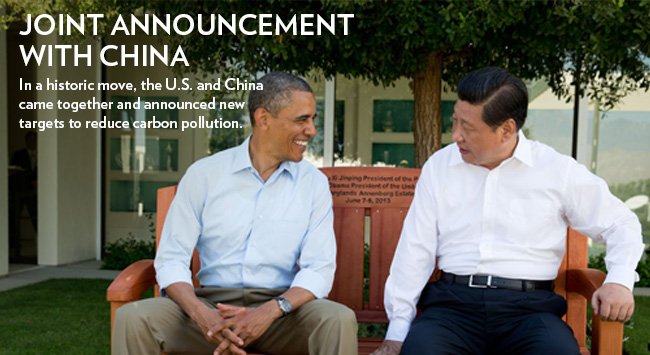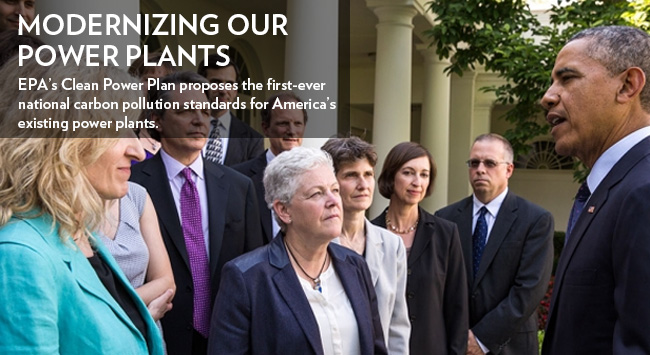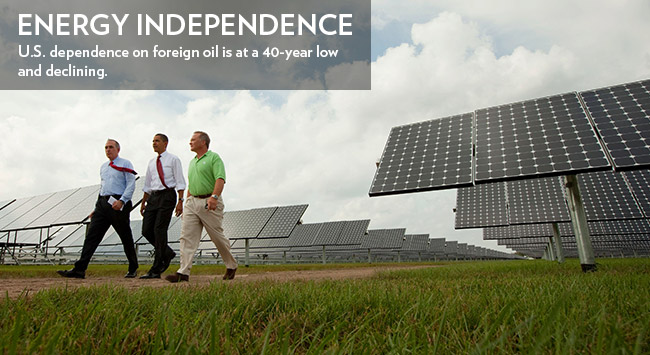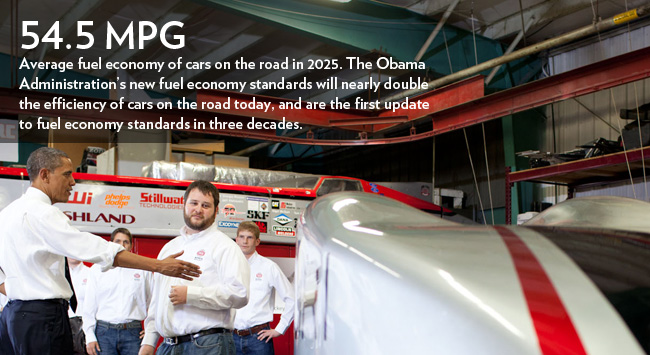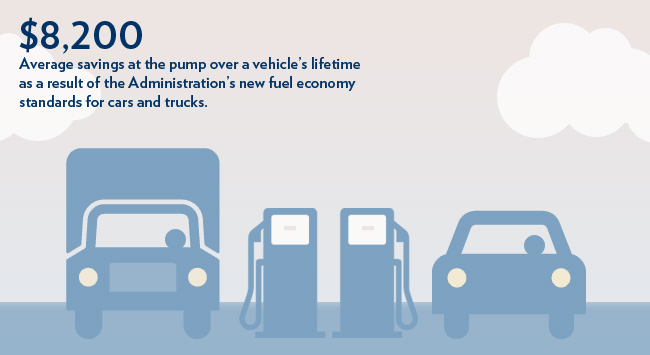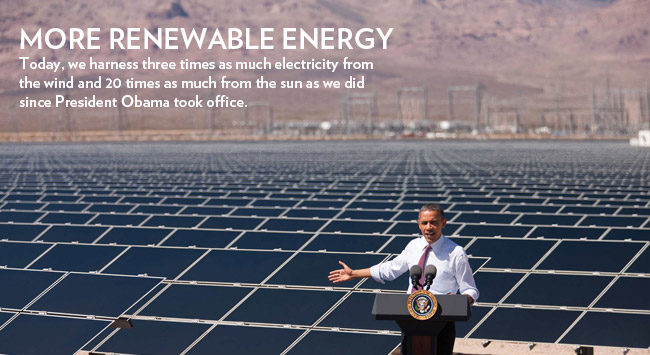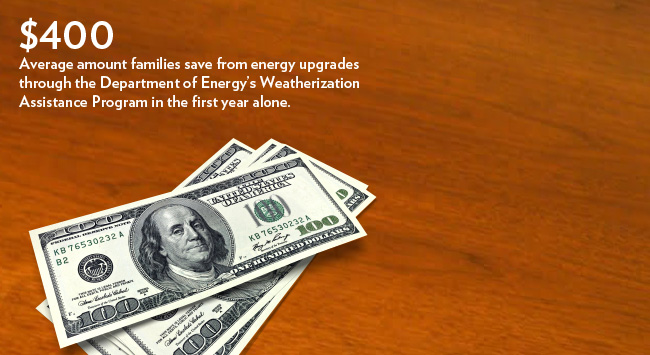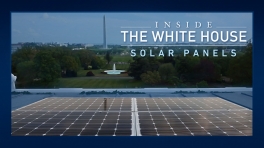Energy and Environment Latest News
The Value of the National Environmental Policy Act
Posted by on May 12, 2015 at 6:51 PM EDTImagine if the Federal government decided to build a six-lane highway straight through your neighborhood, and you had no voice in that decision. Fortunately, we no longer have to confront this scenario – thanks to the National Environmental Policy Act. Today, we take for granted that the public has a right to participate in the Federal decision-making process, but in fact it was NEPA that first established this right. And NEPA has a remarkable 45 year history of driving better quality projects and better outcomes for communities.
Here are a few facts to keep in mind about this landmark environmental law – which was passed with strong bipartisan support to protect people of all backgrounds across the country, and has been emulated around the world.
NEPA leads to better economic and environmental outcomes for communities. There are countless examples of environmental reviews uncovering better project alternatives. Here’s just one example of how this works: At the site of an important Brownfield redevelopment project in South Providence, Rhode Island, the NEPA process for the Providence Community Health Center helped to reveal the existence of potential residual contaminants from lithography chemicals and underground tanks at the historic site. Thanks to NEPA, the Department of Health and Human Services was able to take the necessary steps to move forward with the funding of the redevelopment project in a way that protected human health and minimized the potential for future liability.
More than 90 percent of environmental reviews are completed in a matter of days or weeks. Agencies conduct hundreds of thousands of environmental reviews each year, and the overwhelming number of these use categorical exclusions, the least intensive form of NEPA review. By reducing paperwork and costs, categorical exclusions prevent delays for projects or actions that Federal agencies have previously determined to have no significant effects on the environment.
NEPA doesn’t dictate decisions. NEPA requires that decision makers are thoughtful and transparent about considering the environmental impact of projects. But NEPA doesn’t require agencies to choose the project with the best environmental outcome – in fact it doesn’t dictate any part of their decision about whether to pursue a project. Agencies select projects for a host of different reasons – but NEPA makes sure Americans are aware of the consequences and have a voice in the process.
That’s not to say there isn’t always room for improvement. Under this Administration, the Council on Environmental Quality has led an historic effort to modernize how agencies implement NEPA to improve transparency, public involvement, and efficiency. This includes using technology to increase efficiency and public participation; conducting pilot projects to reduce time and cost involved in preparing NEPA reviews; releasing guidance for agencies that outlines efficiencies that can and should be used for all types of NEPA reviews; and issuing guidance on how agencies can comply with NEPA during emergency situations that demand immediate action. These efforts support the President’s directive requiring agencies to modernize review and permitting of infrastructure with the goal of reducing the aggregate timelines for major infrastructure projects by half.
In the latest step under this modernization initiative, in December we released updated draft guidance for agencies on how to consider greenhouse gas emissions and the impacts of climate change in their NEPA analyses. Considering climate change and its impacts on Federal decisions falls squarely within the scope this bedrock environmental law. Many agencies are doing this already, and Federal courts have said they should. What is missing is consistency in their approach. The guidance will provide agencies with a reasoned approach to addressing a clear environmental impact – climate change – in their environmental reviews.
We are proud of our efforts to make sure that NEPA continues to serve Americans. We keep working with the public, communities, state and local governments, businesses and all stakeholders to ensure they have a seat at the table in the Federal decision-making process – just as NEPA intended.
Taryn Tuss is Communications Director at the White House Council on Environmental Quality.
Learn more about Energy and EnvironmentConnecting America’s Communities with Actionable Climate Science
Posted by on May 6, 2015 at 3:27 PM EDTA year ago today, hundreds of the country’s top climate scientists confirmed that climate change is affecting every region across America in the third U.S. National Climate Assessment (NCA) – the most comprehensive scientific report on domestic climate change impacts ever generated. Since then, communities, localities, and states have continued to use scientific information from the NCA and elsewhere to inform action and make resilience-related decisions on the ground.
Today, in an effort to shine a light on the extraordinary work being done at the regional level and to better understand and address local scale climate-change impacts, President Obama’s Science Advisor John Holdren spent the day with community leaders, scientists, and students at the University of Nebraska—Lincoln (UNL), where researchers are conducting cutting-edge work to develop and deploy actionable climate science.
Learn more about Energy and EnvironmentBuilding for the Future: A New Federal Guide to Infrastructure Planning and Design
Posted by on May 5, 2015 at 1:36 PM EDTToday, the White House is convening the nation’s leading thinkers on infrastructure planning and design to highlight how projects like new roads and transit lines can be designed to foster economic opportunity and increase resilience to the impacts of climate change. To help communities seeking to expand their pipelines of well-designed projects, the Administration is also releasing a Federal Guide to Infrastructure Planning and Design. This community resource guide incorporates programs and opportunities from eight federal agencies and lays out a new set of principles to inform the work of local and State governments, public and private utilities, planners and other stakeholders around the U.S.
The guide is part of the Build America Investment Initiative, an Administration-wide effort to help communities design and finance more and better infrastructure projects. As dozens of studies have suggested, the United States is currently underinvesting in our infrastructure by hundreds of billions of dollars per year. And by 2045, our population will grow by 70 million people, and the demands on our infrastructure systems will grow in parallel. For example, we currently move more than 60 tons of freight per person per year – and by 2045, that will grow by 45 percent.
But it’s not just population and economic growth that will put pressure on U.S. infrastructure. Climate change will also test the strength and endurance of the highways we drive on, the airports we fly out of, and the dams, reservoirs, canals and water facilities that provide water to our homes, businesses and farms. The National Association of Clean Water Agencies, for example, estimates that adaptation to climate change will cost water utilities between $500 billion and a $1 trillion over the next 35 years. Given such challenges, we need to be building smarter by anticipating future demands and integrating new technologies and design methods.
Learn more about Energy and EnvironmentNOAA’s Data Heads for the Clouds
Posted by on May 4, 2015 at 11:53 AM EDTIf you ask the National Oceanic and Atmospheric Administration (NOAA) about big data, they will give you some big numbers. Over 20 terabytes per day of observational data are produced by their satellite systems alone, and then there’s the the massive weather and climate models from the bureau’s 1.5 petaflops of computing power, incoming observations from a network of hundreds of buoys, and live streaming video from the research vessel Okeanos Explorer.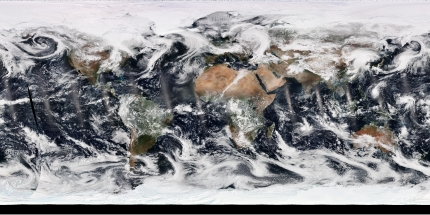
The VIIRS satellite sensor alone currently produces over 2 terabytes of data daily, and the launch of the next-generation GOES-R satellite in 2016 promises to add another 3.5 terabytes each day. (Photo by NASA/NOAA)
NOAA is America’s environmental intelligence agency, and its mission -- to protect life and property, provide the information communities need to become resilient to severe weather- and climate-related events, and conserve and protect national resources -- requires a great deal of number crunching.
The sharing of knowledge and information with others is also part of NOAA’s mission, and it has long been a leader and supporter of government open data efforts. As an agency within the Department of Commerce, NOAA appreciates the importance of private industry and economic growth, and is proud that its data already helps to support vital markets such as the commercial weather, aviation, and insurance industries. Expanding data access even further could create new markets, spur economic growth, and create jobs; research by the McKinsey Global Institute suggests that open data could add more than $3 trillion in total value annually to the education, transportation, consumer products, electricity, oil and gas, healthcare, and consumer finance sectors worldwide.
However, the effort and cost involved in distributing tens of terabytes of data daily is staggering, and so the agency has been seeking innovative ways to increase its data’s availability without exhausting its own resources in the process. In early 2014, NOAA reached out to the private sector through a Request for Information to enlist help in making data available to the public in a rapid, scalable, and inexpensive manner. The response was overwhelmingly positive, with over 70 responses to the initial RFI and over 200 companies represented at a subsequent Industry Day last October. It was clear that industry saw great untapped economic potential in making NOAA’s environmental data more accessible, and that this economic potential could far outweigh the data distribution costs.
Amongst all of the support and enthusiasm, though, there were still a great many open questions about the specifics of the implementation and the business model, which questions could not be answered without further input and innovation from industry. Reaching out to the Infrastructure-as-a-Service (IaaS) providers mentioned most frequently by RFI respondents, NOAA suggested a joint experiment: If the IaaS providers could help to position NOAA’s data next to their own high performance computing, analytic, and storage services, would the rest of the private sector take advantage of that positioning to run algorithms, perform research, and create inventions? Might the revenue gained from new products, infrastructure services, and analytics be so great that it could help cover the cost of the original data dissemination, creating a self-sustaining ecosystem?
Taking Action for America’s PrepareAthon!
Posted by on April 30, 2015 at 10:24 AM EDTWhen a disaster hits, Americans often have to act fast to keep their families safe and protect their homes and businesses from harm. But responding to an emergency takes more than fast action. To ensure an effective response, Americans must prepare in advance to identify the risks they face, know which steps to take to prepare, and understand their community’s plan.
That’s the idea behind America’s PrepareAthon! National Day of Action. As a nation, we’ve made great progress building and sustaining national preparedness, but we still face diverse threats that challenge our collective security and resilience. And today, individuals, families, and communities across the country are coming together to take action to prepare for some of those threats, including tornadoes, hurricanes, floods, earthquakes, wildfires, and winter storms.
Learn more about Energy and EnvironmentWeek in Review: A Conversation About Our Environment
Posted by on April 24, 2015 at 5:33 PM EDTFrom an Earth Day trip to a 1.5-million-acre wetland ecosystem to a trade deal that protects endangered species, this was a week of conversation about how we can protect our environment. President Obama traveled to the Everglades in southern Florida to discuss how climate change is affecting our environment and spoke about his trade deal that would protect endangered species from illegal wildlife trafficking. Back at the White House, we reviewed our progress on combating environmental challenges and asked you to share what you would fight to protect for this Earth Week.
In case you missed it, here are a couple highlights from the week.
Recapping Earth Day
On Wednesday, the President traveled to the Everglades in southern Florida for the first time to celebrate Earth Day. While enjoying the natural beauty of the 1.5-million-acre wetland ecosystem, President Obama also highlighted how climate change is affecting the region and our planet. The President also sat down with Bill Nye the Science Guy to discuss that threat, conservation, and science education in America. Watch that conversation below:
Take a look at our highlights from the day.
Learn more about Energy and Environment
- &lsaquo previous
- …
- 5
- 6
- 7
- 8
- 9
- 10
- 11
- 12
- 13
- …
- next &rsaquo
White House Blogs
- The White House Blog
- Middle Class Task Force
- Council of Economic Advisers
- Council on Environmental Quality
- Council on Women and Girls
- Office of Intergovernmental Affairs
- Office of Management and Budget
- Office of Public Engagement
- Office of Science & Tech Policy
- Office of Urban Affairs
- Open Government
- Faith and Neighborhood Partnerships
- Social Innovation and Civic Participation
- US Trade Representative
- Office National Drug Control Policy
